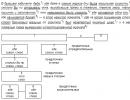Mass layoffs are a percentage of the total number of employees. Mass dismissal of workers
When an enterprise is at the stage of bankruptcy, in order to try to re-raise the level of solvency, it is necessary to take emergency measures.
Employers and owners often resort to fairly common measures:
- shorten the working day, in connection with which the cost of wages is reduced accordingly;
- introduce a shortened working week;
- reduce wages to keep the staff,
and also use other methods that do not always justify themselves, and ultimately the question arises of reducing a significant staff, or liquidating the enterprise altogether.
This process is rather painful for any enterprise and organization, since it is not always possible to offer people another job, and, accordingly, the released employees join the ranks of the unemployed.
If some part of the employees is dismissed from the enterprise during the downsizing, then during liquidation and if the enterprise is declared bankrupt (sometimes at the initiative of the owner), almost all employees are dismissed, except for those rare cases when the organization has some branches or subsidiary, where employees can be transferred at their request. Although most people refuse to transfer due to the remote location of these organizations from their permanent place of residence and lower pay.
Let's take a closer look at the issue of mass layoffs.
What it is, and what legal norms must be observed in case of mass reduction and dismissal in connection with the liquidation of a large number of employees from the organization.
What it is
There are private enterprises, where, for example, 10-20 people work, and there are state-scale enterprises with several thousand employees.
The mass dismissal of workers is the number of people released from work, defined in specific agreements by industry, taking into account their location.
These agreements take into account all the features of the development of the economy in each region, which have their own characteristics and differences.
According to Article 81 of the Labor Code of the Russian Federation, dismissal is possible in connection with the complete liquidation of the enterprise and the reduction of the staff.
In 2017, the criteria for the release of workers, which can be considered mass, are determined in accordance with the Decree of the Council of Ministers of the Russian Federation No. 99 of February 5, 1993, which has not lost its relevance at the present time.
How many people is this
So, we found out that mass dismissal is considered depending on how many people in relation to the total number of employees are fired from the enterprise for a certain period of time.
1. So the dismissal of people from a bankrupt enterprise (organization) from work is considered mass, if the number is even fifteen and, accordingly, more people.
2. Mass dismissal, if the enterprise:
- in a month, as a result of the reduction, fifty or more people are fired;
- for 2 months more than two hundred people;
- for 3 months more than five hundred people.
3. For regions where the total number of employment of the population is less than 5,000 people, even the dismissal of 1% of employees per month from the total number of workers is considered to be a mass dismissal due to a reduction in staff or the liquidation of an organization.
With the current economic situation in the country and the labor market, the mass release of labor resources can be suspended for up to six months if the regional unemployment rate is less than 11% of the population.
The decision to suspend the reduction is made at the local level by self-government bodies if an offer is received from the employment service and trade unions in connection with the growth of unemployment.
If, for example, in the region the unemployment rate is above 11%, then the mass dismissal of workers can occur in stages in the following terms:
- within eight months, fifty or more people;
- for ten months more than two hundred people;
- five hundred people or more per year.
Current regulations
When it becomes necessary to take extreme measures, such as reducing the number of employees, or laying off all employees during the complete liquidation of the enterprise, if it is declared bankrupt, it is necessary to comply with current legislation.
According to the Law of the Russian Federation No. 1032-1, adopted on 19.04. 91 “On employment of the population”, mass dismissal should occur only after the trade union bodies have been notified three months before the start of the process and are monitoring compliance with the law.
Regional employment services at the location of the enterprise, which is going to lay off people in large numbers, must also be notified in writing two months before the start of layoffs and applications for employment of the unemployed.
The Labor Code of the Russian Federation regulates mass dismissal in several articles, as well as all issues related to labor relations and their termination.
- Article 74 allows for the possibility of introducing a part-time or work week in order to try to avoid layoffs to get the organization out of financial difficulties.
- Article 81 provides for the possibility of dismissal in connection with the reduction or liquidation of the organization.
- Article 79 defines preferential categories that cannot be dismissed due to a reduction, although these benefits do not apply in the event of a complete liquidation of an enterprise.
- Article 82 regulates the procedure for notifying the primary trade union body of the decision by the owner to reduce the number two months before the start of the dismissal itself, and in case of mass reduction - three months in advance.
- The norms of Article 180 provide for the obligation of the employer, before dismissing an employee, to offer a transfer to another position or workplace available in the vacancy at the time of dismissal due to a reduction.
- Article 140 enshrined at the legislative level that the payments due must be made, regardless of the reason for dismissal, on the day when, according to the order, the employee is considered to be released from labor duties to the organization.
- Article 178 obliges to assign a severance pay for up to three months, in cases where a person who has been laid off or left without a job due to bankruptcy and liquidation of an enterprise, was registered with an employment center within two weeks, but due to the lack of suitable vacancies cannot be employed.
- Article 373 regulates the consideration of the opinion of trade union bodies on the decision by management on the need and justification for the dismissal of employees in connection with the reduction.
What problems may arise
Mass dismissal is a rather time-consuming and responsible moment. It is essential that all labor laws are observed.
1. Particular attention should be paid to situations where there is a reduction in the number of employees of those categories who cannot be fired, even if they have lower qualifications compared to other specialists and have less work experience than those working nearby, but who do not have such benefits.
These include:
- pregnant women;
- mothers raising children under 14 without a father (and in cases where the child is disabled, then up to eighteen years);
- in the absence of parents, persons replacing them for young children and, of course, children with disabilities.
2. It is important that the trade union bodies and the employment center are notified within the time period established at the legislative level about the upcoming mass dismissal.
3. When reducing a large number of employees, the employer is faced with the problem of offering other jobs and positions for the employment of the laid-off workers.
4. When carrying out both the dismissal procedure during a staff reduction, and during the closure or liquidation of an enterprise, it is necessary to refer to specific norms of labor legislation so that there are no later controversial questions about the correctness and legality of the actions of the enterprise management.
The procedure for mass layoffs in Russia in 2017
Each leader faced with the problem of mass layoffs must follow a certain sequence of their actions.
We give a step-by-step algorithm of actions.
- Develop and approve a new staffing table for the number of employees either throughout the organization or a certain category of specialists and workers.
- Issue an order for the enterprise to reduce according to the newly adopted staffing table.
- Notify in writing the trade union body of the enterprise in the event of a mass layoff three months in advance and the regional employment center about the upcoming release of employees two months before the start of the process itself.
- Two months in advance to warn people in writing about the upcoming reorganization and the reasons for their dismissal. If there are vacancies, offer a transfer to a new position. If a person refuses to sign this warning, draw up an appropriate act signed by at least two witnesses, or send it to the home address by registered mail with acknowledgment of receipt.
- A dismissal order is being prepared, it is introduced under the personal signature of each employee with whom the employment relationship is terminated. In case of refusal to sign, appropriate marks are made similar to the refusal to sign a warning.
- Entries are made in the work books of dismissed employees indicating the reason, a reference to the norm of labor legislation, the number and date of issue of the dismissal order.
- Employees laid off or dismissed due to the termination of the enterprise's activities are paid on the last day of their work all the due payments, taking into account the severance benefits stipulated in accordance with Articles 178 and 180 of the Labor Code of the Russian Federation. That is, if a person, having learned about the upcoming reduction, without waiting for a two-month period, agrees to quit by agreement of the parties, he is also entitled to a severance pay in the amount of average monthly earnings when calculating.
- After the termination of the dismissal procedure, information about already dismissed employees is submitted to the employment center, since they may differ from those previously submitted (a number of employees may have been transferred to other positions).
Order formation
When issuing a dismissal order, justification is required:
- court decision on recognition of bankruptcy and liquidation of the enterprise;
- decision of the general meeting of founders on the termination of activities or reorganization and the need for a reduction in the number of employees;
- bringing the number of employees in line with the new staffing table and others.
An order is formed in any form, but the following must be indicated:
- full name of the enterprise;
- publication date;
- a list of laid-off workers, indicating the position (profession), site, unit where they work.
The order must be registered in due order in the book of registration of orders with the assignment of a number and an indication of the date.
It must be signed by the head of the organization and agreed with the legal service (if one exists at the enterprise) and the trade union body.
How to make an action plan
Before you start layoffs or mass layoffs due to liquidation, you need to develop a plan so as not to miss important points.
1. It is necessary to prepare for the mass layoff of workers.
At this stage, it is important to warn the trade union bodies and the employment service of a significant dismissal.
Familiarize yourself with the data of candidates to be reduced in order not to get into a mess by firing people who, according to the law, are not entitled to be fired under any circumstances.
Consult with lawyers on the legality of the activities.
2. The next step is to notify employees of the upcoming dismissal.
It is important here that there is evidence that people were indeed given two months notice that they would be fired, as well as the reasons for this decision.
3. At the final stage, laid-off employees are transferred to new vacant positions or are fired in accordance with the law.
A package of necessary documents
The manager can confirm the necessity and correctness of the mass dismissal by collecting the necessary package of documentation.
The company must have:
- The validity of the creation of a new staffing table and the schedule itself, approved by order. Or, in the event of liquidation of the enterprise and the need to dismiss all employees, this should be a court decision declaring bankruptcy.
- Developed and approved action plan.
- Extracts from the personal files of employees who fell into the category of candidates for layoffs.
- Minutes of the meeting of the commission on the consideration of candidates for dismissal (with reduction).
- An order for the upcoming mass dismissal indicating the list of names of employees and their personal signatures that they are familiar with.
- A signed act on the proposed vacancies for transfer to another job and relevant documents on the consent or refusal of the employee to transfer.
- Confirmation of sent letters to the trade union bodies and the employment service.
- Minutes of the meeting of the trade union committee with the consent or justified refusal of the upcoming reduction.
- The final order to reduce or dismiss employees with an edited list of names.
- Corresponding entries in the personal cards of dismissed employees.
- Accounting documents confirming compensation payments received by laid-off employees.
The criteria for the mass dismissal of workers are determined in industry and (or) territorial agreements (part 1 of article 82 of the Labor Code). This makes it possible to take into account the territorial and sectoral features of the development of the economy and the level of unemployment in the region. However, at present, until the issue of criteria in sectoral and (or) territorial agreements is resolved, the criteria for mass layoffs established by the Decree of the Council of Ministers - the Government of the Russian Federation "On the organization of work to promote employment in conditions of mass layoffs" are applied. In accordance with this resolution, the main criteria for mass layoffs are the indicators of the number of dismissed employees in connection with the liquidation of the organization or the reduction in the number or staff of employees for a certain calendar period. These include:
a) liquidation of an enterprise of any legal form with 15 or more employees;
b) reduction in the number or staff of employees of the enterprise in the amount of:
50 people and more - within 30 calendar days; 200 people and more - within 60 calendar days; 500 people and more - within 90 calendar days;
c) dismissal of employees in the amount of 1% of the total number of employees due to the liquidation of the enterprise or reduction in the number or staff within 30 calendar days in regions with a total number of employees less than 5 thousand people.
Taking into account the situation developing in the labor market, the decision of employers on mass dismissal can be suspended for up to six months. Such a decision is made by the local government at the suggestion of the employment service and trade union bodies. The specific timing of the suspension of mass layoffs depends on the level of unemployed in the region.
┌─────────────────────────────────────────┬───────────────────────────────┐
│ Unemployment rate (in % of headcount │ Potential suspension period │
│ employed in the region) │ releases │
│ 3-5 │ 1 month │
├─────────────────────────────────────────┼───────────────────────────────┤
│ 5-7 │ 2 months │
├─────────────────────────────────────────┼───────────────────────────────┤
│ 7-9 │ 3 months │
├─────────────────────────────────────────┼───────────────────────────────┤
│ 9-11 │ 4 months │
├─────────────────────────────────────────┼───────────────────────────────┤
│ over 11 │ 6 months │
└─────────────────────────────────────────┴───────────────────────────────┘
If the unemployment rate in the region exceeds 11%, the phased release of workers can be carried out in the following terms:
┌──────────────────────────────────────────┬──────────────────────────────┐
│Number of dismissed employees (persons) │ Set term │
│ │ phased release │
Mass layoffs - how many people?
When a large number of employees are reduced, this is already a mass layoff. This is how many people should be reduced to be recognized as such? In this article we will try to answer this and other questions.
About reduction
Reducing the number of employees or staff is a legitimate tool for the employer. This is one of the grounds for dismissal at the initiative of the employer.
The employer has the right to independently change the system of subordination and the structure of the organization, make decisions to optimize the entire work process, change the staffing table or the number of employees. And the legislation does not oblige the employer to justify his decision to the employees.
But at the same time, the good faith of the employer and the absence of abuse of the right on his part are assumed. This means that, having reduced the number of employees from 10 to 2, he will not increase the department “tomorrow” by the same 8 people. The risk of challenging the employer's order is very high. And if the employer is not obliged to report to the employee, then in court in the event of a dispute, he will still have to prove that the mass reduction was a forced and necessary measure.
Mass reduction
Legislation does not provide a definition for ordinary and mass layoffs.
The reduction in the number of employees implies a decrease in the number of employees replacing the same positions.
If individual positions or entire divisions are excluded from the staff list, we are talking about staff reduction.
Mass layoffs mean layoffs of a large number of employees. But what exactly is the amount?
Criteria
Mass character criteria for dismissal are determined in industry and (or) territorial agreements.
| industry agreement | Criteria for mass layoffs of workers |
|---|---|
| by rail transport companies | Reduction of 5 percent or more within 90 calendar days |
| between the Russian Trade Union of Cultural Workers and the Ministry of Culture of the Russian Federation | Simultaneous reduction within 30 calendar days:
|
Between:
| Reduction in quantity:
|
If there is no agreement in a particular industry or what exists does not apply to the organization, then the criteria for mass character are determined according to clause 1 of the Regulation, approved. Decree of the Council of Ministers of the Russian Federation of 05.02.1993 N 99. According to it, a dismissal is considered massive if it is reduced:
- 50 people and more within 30 calendar days;
- from 200 and more - within 60 days;
- from 500 and more - within 90 days;
- 1% of the total number of employees for 30 calendar days in regions where the total number of employees is less than 5,000.
In case of mass reduction, how much notice is given?
Notifying workers and government agencies in case of mass layoffs is just as mandatory as in the case of a regular one.
You need to notify:
Mass layoffs and part-time jobs
With a potential threat of mass layoffs, the employer has the right to unilaterally introduce a part-time regime (Article 74 of the Labor Code of the Russian Federation). But before introducing such a regime, it is necessary to take into account the opinion of the trade union. Unless, of course, he is in the company.
With a large number of workers is called massive. Labor legislation specifically stipulates the features of this type of dismissal.
What is mass layoff
A mass layoff is the termination of an employment relationship with a certain number of employees over a certain period of time.
A mass layoff is always understood as a reduction, the need for which may arise for various reasons:
- The difficult financial situation of the employer;
- Complete liquidation of the enterprise;
- Modernization of production.
The legislation does not stipulate specific cases when it is possible and when it is impossible to resort to mass reduction.
The legislative framework
There are no specific instructions in the Labor Code when layoffs become massive. It is only indicated here that these criteria can be determined by industry agreements (clause 1, article 82).
More specific information is provided by Government Decree No. 99 dated February 5, 1993. In the general provisions of this document, one can find the main signs by which the dismissal can be called massive. But he also admits that other figures can be used, provided that they are spelled out in the agreements.
Thus, even within the same region, the reduction of the same number of people can be attributed to different categories.
This concept is also mentioned in Art. 74 of the Labor Code of the Russian Federation, in which the employer is given the right to establish part-time work in case of a threat of mass dismissal. But this is only a right, not an obligation, so the employer has the right to immediately carry out a reduction.
Mass layoff criteria
The criteria for mass layoffs are determined by two parameters:
- The number of employees with whom the contract will be terminated as part of the reduction (that is, if during this period someone is fired of his own free will or for negative reasons, he will not be included in the number);
- The time for which the dismissal will be carried out. It is counted in calendar days.
The following criteria currently apply:
- Complete liquidation of the employer, provided that the number of employees is not less than 15 people;
- If 50 or more employees are fired within 30 days;
- If 200 or more employees are laid off in 60 days;
- If 500 or more employees lose their jobs in 90 days;
- If in a region where the employed population is less than 5 thousand, 1% or more of this number will be laid off in 30 days, regardless of whether the company is being liquidated or is making cuts.
These are the main criteria, they are used if there are no industry agreements.
It is worth noting that most of the existing industry agreements have also approved these figures. But there are areas in which others are used. For example, for organizations that report to the Ministry of Education, these figures are reduced and are:
- 20 workers in 30 days;
- 60 workers in 60 days;
- 100 workers in 90 days.
And also the dismissal of 10% of employees in the company in 90 days is recognized as mass.
Mass dismissal: procedure and features
Since mass dismissal is a reduction, it is carried out according to paragraph 2 of Art. 81 of the Labor Code of the Russian Federation. But there will be a few differences:
- The first and main difference is the period for which employees are warned about the upcoming end of the employment relationship. In case of mass reduction, it should be no less than three months;
- Mandatory notification of the trade union or other authorized body of employees;
- You need to notify the employment center three months in advance. A special form is provided for the warning, approved by the same Decree No. 99.
Note! Three months in advance, you only need to submit the above form, stating that a massive reduction is expected. And information about specific employees who will be fired can be sent, as usual, no later than two months in advance, for which there is also a special notification form.
Mass dismissal of workers is the dismissal of a large number of employees that meets the criteria specified in the labor law. The main difference in carrying out this event from the usual reduction is the period for which the company must warn employees about the dismissal, it is three months.
The mass dismissal of workers is a complex process in technical and moral terms, but it is inevitable if it is required by production necessity and objective economic conditions. This step is fraught with many undercurrents that can be avoided by following the letter of the law and competent legal support.
What is mass reduction?
This is a process when, in a certain period of time, a large number of employees are fired at an enterprise. The dimensions of the mass character depend on the length of time during which this happens.
The concept of mass layoffs has a legal definition - a lockout. The concept means the ratio of the number , to the total number of employees in the organization. The ratio is always different in different enterprises.
The criteria for mass layoffs are regulated in Government Decree No. 99, where it is explained that mass layoffs are how many people. Criteria:
- Complete liquidation of the enterprise with the number of employees from 15 people.
- Reduction from 50 employees within 1 month.
- Dismissal of 200 people in 2 months.
- Dismissal to reduce staff from 1% of employees in the territory where the number of able-bodied population is less than 5 thousand people.
If a mass layoff of employees is brewing at the enterprise, but a final decision on this has not been made, then the employer is recommended to take a number of measures. It is possible that some of them will help prevent mass layoffs of workers:
- notify local authorities about the situation at the enterprise;
- hold a meeting of employees to inform them about the current situation and smooth out the tense situation;
- consider changing the profile of the enterprise;
- stop hiring new employees;
- to consider the possibility of transferring employees to a part-time position.
If the activities are carried out with the direct participation of local authorities who are interested in preserving the city-forming enterprises, then there is hope for preventing liquidation. But in the event that the situation has reached an impasse, management needs to consider getting employees fired in accordance with the Labor Code.
How is a mass layoff carried out?

The dismissal of a large number of employees from one enterprise is fraught with difficulties, both psychological and documentary. The personnel service must comply with the algorithm of actions defined by law and the criteria for mass reduction:
- Development of a new staffing table with an updated number of employees.
- Issuing an order for the organization to reduce.
- Notification of the trade union organization about the upcoming procedure 3 months before the start.
- Warning employees that layoffs are coming.
- An offer to applicants to fill other vacancies that are available. The positions offered must correspond to the qualifications of the dismissed.
- Providing documentation of mass layoffs to the trade union.
- Coordination of controversial issues between the administration and the trade union organization.
- Preparation of work books.
- Calculation of employees in accounting.
An action plan must be drawn up for the main reduction order, according to which the procedure will be carried out. The text of the order must include a clause on the appointment of a commission responsible for the implementation of planned activities.
Possible difficulties
It is difficult to avoid problems when laying off a large number of people. It is necessary to provide for the existence of categories of workers who, by law, are not subject to reduction. If the move is unavoidable, then they should get an offer for another job first. They have the right to terminate the employment contract only at their own request:
- women without a husband who are dependent on children under 14;
- women raising a disabled child;
- citizens who substitute parents for minors and children with disabilities.
When analyzing the lists of laid-off employees, it is necessary to exclude these employees from the number of those who were made redundant.
The Employment Center should be aware of ongoing events 3 months before they start. Otherwise, the head of the enterprise faces a fine as an individual in the amount of 3,000 rubles, and a fine of up to 50 thousand rubles will be imposed on the organization.

The employer is obliged to weightily argue the need for dismissal before the trade union, which is obliged to protect the rights of employees of the enterprise and strictly monitors compliance with the criteria for mass dismissal. The trade union may reasonably disagree with the decision of the administration, about which it issues its opinion. A complaint against management is filed with the labor inspectorate, which concludes that the employer's decision complies with the law.
Guarantees for employees
3 months before the start of the dismissal, the company issues an order on the course of the procedure. The document lists the citizens included in the list of reduced ones. One of the points of the order is the mention that they must be paid all due funds. Each employee is given a severance pay based on his average monthly earnings. This amount is tripled. If an employee has unused vacation left in stock, then it is fully paid.
Payments are made even if the employee terminates the employment agreement before the official date of dismissal. Bonuses issued to all employees for the period from the beginning of the issuance of the order until the moment of dismissal are also paid to applicants for reduction. According to the Tax Code, all payments should not be taxed.






